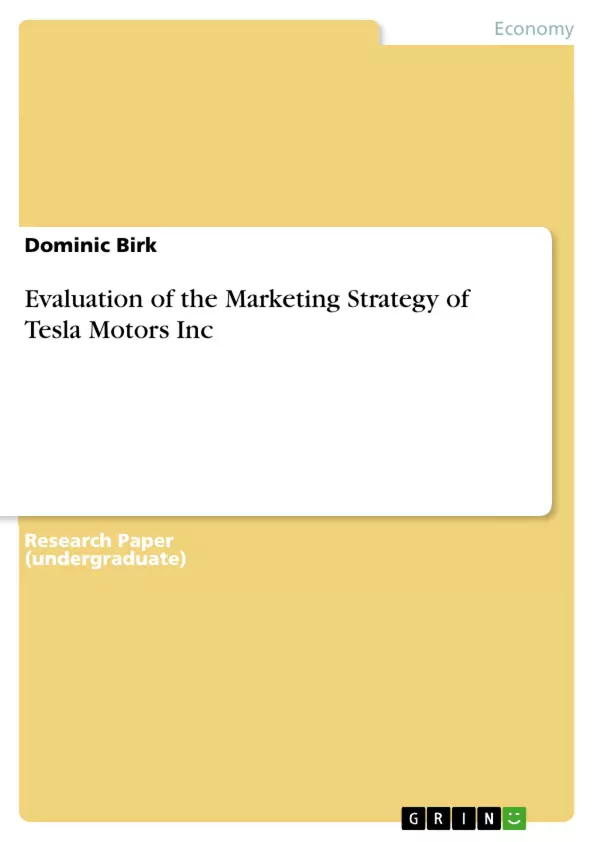Tesla Motors, Inc. is a car manufacturer, which polarizes like no other company in this industry. It is often said that with its business model and its special strategic moves, Tesla confuses competitors, utilities and marketing agencies.
Therefore, this assignment will focus on the analysis of the key aspects of Tesla’s business model in order to find out why it is considered to be different. Moreover, the objective of this assessment is to find out, whether this strategy is useful, or if it should be changed.
The market definition and analysis of the first assignment is hereby the basis for this evaluation of Tesla Motor’s current marketing strategy. Therefore, the focus will be again on the company’s domestic market: the United States of America. Furthermore, only Tesla’s automotive products will be taken into consideration – its recently launched home battery will not be object of this work.
Table of Contents
- 1. Introduction
- 1.1 Problem Definition and Objective
- 1.2 Structure
- 2. Current Market Position
- 3. Marketing Mix
- 3.1 Customer Value
- 3.1.1 Product Portfolio
- 3.1.2 Portfolio Analysis
- 3.1.3 Product Life Cycle
- 3.2 Customer Cost
- 3.2.1 Pricing Strategy of Tesla Motors
- 3.2.2 Pricing Strategy Competitors
- 3.3 Convenience
- 3.3.1 Distribution Levels
- 3.3.2 Channel Strategy
- 3.4 Communication
- 4. Conclusion and Outlook
Objectives and Key Themes
This assignment analyzes Tesla Motors' marketing strategy to determine its effectiveness and identify potential areas for improvement. The focus is on the U.S. market and Tesla's automotive products, excluding the home battery. The analysis utilizes the "Four Cs" framework, examining customer value, cost, convenience, and communication.
- Evaluation of Tesla's unique marketing approach
- Analysis of the effectiveness of Tesla's marketing mix
- Assessment of Tesla's current market position
- Identification of key factors contributing to Tesla's success or challenges
- Recommendations for future marketing strategies
Chapter Summaries
1. Introduction: This chapter introduces the study's focus on Tesla Motors' marketing strategy, highlighting the company's polarizing nature and its unconventional business model. The objective is to analyze key aspects of Tesla's strategy to assess its effectiveness and identify potential areas for improvement. The study is based on a previous market analysis focusing on the U.S. market and considers only Tesla's automotive products.
2. Current Market Position: This chapter (details not provided in the excerpt) would likely detail Tesla's position within the automotive market in the U.S., analyzing market share, competitive landscape, and overall market trends impacting Tesla’s performance. It would likely set the stage for a deeper dive into the company’s marketing strategies in subsequent chapters.
3. Marketing Mix: This chapter provides a comprehensive analysis of Tesla's marketing mix, examining the "Four Cs" – Customer Value, Customer Cost, Customer Convenience, and Communication. It would likely delve into specific aspects such as Tesla's product portfolio, pricing strategies, distribution channels, and communication methods (e.g., social media engagement, advertising), providing a detailed examination of each element and how they contribute to the overall marketing strategy. The analysis would consider both Tesla's strategies and those of their competitors.
Keywords
Tesla Motors, marketing strategy, marketing mix, customer value, customer cost, customer convenience, communication, product portfolio, pricing strategy, distribution channels, electric vehicles (EVs), competitive analysis, U.S. market.
Tesla Motors Marketing Strategy Analysis: Frequently Asked Questions
What is this document about?
This document provides a comprehensive preview of a language analysis focusing on Tesla Motors' marketing strategy. It includes a table of contents, objectives and key themes, chapter summaries, and keywords. The analysis uses the "Four Cs" framework (Customer Value, Cost, Convenience, and Communication) to evaluate Tesla's approach in the US automotive market.
What are the main objectives of this analysis?
The analysis aims to evaluate Tesla's unique marketing approach, analyze the effectiveness of its marketing mix, assess its current market position, identify factors contributing to its success or challenges, and provide recommendations for future marketing strategies.
What framework is used for the analysis?
The analysis utilizes the "Four Cs" framework, examining Customer Value, Customer Cost, Customer Convenience, and Communication. This framework provides a comprehensive approach to analyzing Tesla's marketing strategy.
Which aspects of Tesla's business are included in this analysis?
The analysis focuses on Tesla's automotive products in the U.S. market, excluding its home battery products.
What are the key chapters and their summaries?
Chapter 1 (Introduction): Introduces the study's focus on Tesla's marketing strategy, highlighting its unconventional business model and the aim to assess its effectiveness. Chapter 2 (Current Market Position): Details Tesla's position within the U.S. automotive market, analyzing market share, competitive landscape, and relevant market trends. Chapter 3 (Marketing Mix): Provides a detailed analysis of Tesla's marketing mix using the "Four Cs" framework, examining its product portfolio, pricing, distribution, and communication strategies.
What are the key themes explored in the analysis?
Key themes include Tesla's unique marketing approach, the effectiveness of its marketing mix, its current market position, the factors driving its success or challenges, and recommendations for future strategies.
What keywords are associated with this analysis?
Keywords include: Tesla Motors, marketing strategy, marketing mix, customer value, customer cost, customer convenience, communication, product portfolio, pricing strategy, distribution channels, electric vehicles (EVs), competitive analysis, and U.S. market.
- Quote paper
- Dominic Birk (Author), 2015, Evaluation of the Marketing Strategy of Tesla Motors Inc, Munich, GRIN Verlag, https://www.grin.com/document/309706



